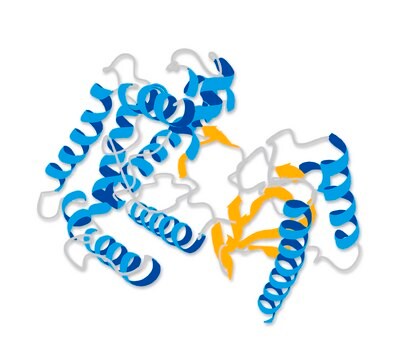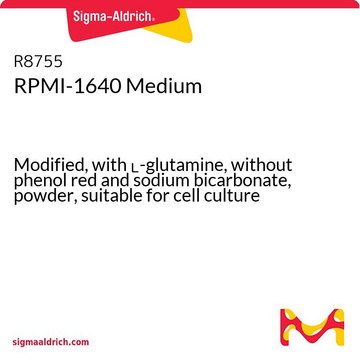CC1028
ADAMTS-4, recombinant, His Tagged
This His Tagged Recombinant ADAMTS4 is used to study the degradation of extracellular matrix proteoglycans, to screen for inhibitors of proteoglycan hydrolysis and to characterize inhibitor actions.
Sinonimo/i:
Aggrecanase 1
Autenticatiper visualizzare i prezzi riservati alla tua organizzazione & contrattuali
About This Item
Codice UNSPSC:
12352204
eCl@ss:
32160405
NACRES:
NA.41
Prodotti consigliati
Origine biologica
human
Livello qualitativo
Ricombinante
expressed in baculovirus
Stato
liquid
Produttore/marchio commerciale
Chemicon®
N° accesso NCBI
N° accesso UniProt
Condizioni di spedizione
dry ice
Informazioni sul gene
human ... ADAMTS4(9507)
Descrizione generale
ADAMTS (a disintegrin and metalloproteinase with thrombospondin motif) is a novel family of extrcellular proteinases (Tang, 2001). Presently nine family members have been identified in mammals (Tang, 2001). ADAMTS4 was first purified from IL-1-stimulated bovine nasal cartilage conditioned media and human ADAMTS4-cDNA was cloned from a human heart cDNA library (Tortorella, 1999). Mature ADAMTS4 consists of a prodomain which confers latency to the proenzyme, a catalytic domain, a disintegrin domain and a C-terminal sequence with a thrombospondin type-1 motif. The prodomain is most likely cleaved off by a furin-type enzyme before active ADAMTS4 is released from cells. Active ADAMTS4 consists of 625 amino acids (F213 - K837) with a calculated Mr of 67 943 (Tortorella, 1999).
ADAMTS4 hydrolyzes aggrecan, the major proteoglycan of articular cartilage (Tortorella, 1999). As aggrecan is also digested by 2 other members of the ADAMTS family, ADAMTS1 (Kuno, 2000) and ADAMTS5 (Abbaszade, 1999), aggrecan degradation products found in normal and rheumatoid and osteoarthritic joint cartilage (Lark, 1997) may arise from action of either of the 3 proteinases. Isolated ADAMTS4 hydrolyzes aggrecan at 5 different sites (Tortorella, 2000a). Four cleavage sites are located in the chondroitin sulfate-rich region between globular domains G2 and G3, while one site is placed in the rod-shaped polypeptide between globular domains G1 and G2. The thrombospondin motif in ADAMTS4 appears to be critical for aggrecan substrate recognition and cleavage (Tortorella, 2000b). ADAMTS4 hydrolyzes also other lecticans as brevican (Nakamura, 2000) and versican (Sandy, 2001).
ADAMTS4 is inhibited by TIMP 3 (Hashimoto, 2001) and by the N-terminal domain of TIMP 3 (Kashigawa, 2001) with Ki-values in the nanomolar range. Inhibition by TIMP 1,2, and 4 is much weaker (Hashimoto, 2001).
ADAMTS4 hydrolyzes aggrecan, the major proteoglycan of articular cartilage (Tortorella, 1999). As aggrecan is also digested by 2 other members of the ADAMTS family, ADAMTS1 (Kuno, 2000) and ADAMTS5 (Abbaszade, 1999), aggrecan degradation products found in normal and rheumatoid and osteoarthritic joint cartilage (Lark, 1997) may arise from action of either of the 3 proteinases. Isolated ADAMTS4 hydrolyzes aggrecan at 5 different sites (Tortorella, 2000a). Four cleavage sites are located in the chondroitin sulfate-rich region between globular domains G2 and G3, while one site is placed in the rod-shaped polypeptide between globular domains G1 and G2. The thrombospondin motif in ADAMTS4 appears to be critical for aggrecan substrate recognition and cleavage (Tortorella, 2000b). ADAMTS4 hydrolyzes also other lecticans as brevican (Nakamura, 2000) and versican (Sandy, 2001).
ADAMTS4 is inhibited by TIMP 3 (Hashimoto, 2001) and by the N-terminal domain of TIMP 3 (Kashigawa, 2001) with Ki-values in the nanomolar range. Inhibition by TIMP 1,2, and 4 is much weaker (Hashimoto, 2001).
Molecular form: Recombinant human ADAMTS4 delta580-837 is produced with the baculovirus expression system and purified from insect cell culture supernatants. The protein consists of amino acids F213 to A579 of full-length ADAMTS4 and a C-terminal His6tag. The calculated Mr is 40,366 Da.
Inhibitors: ADAMTS4 is inhibited by tissue inhibitors of matrix metalloproteinases 3 (TIMP 3) and to a lesser extend by other tissue inhibitors. Enzyme activity is also suppressed by chelators of divalent captions as EDTA and by synthetic metalloproteinase inhibitors.
Applications: Recombinant ADAMTS4 is used to study the degradation of extracellular matrix proteoglycans, to screen for inhibitors of proteoglycan hydrolysis and to characterize inhibitor actions. The enzyme can also serve as standard in enzymatic and immunochemical assays.
Inhibitors: ADAMTS4 is inhibited by tissue inhibitors of matrix metalloproteinases 3 (TIMP 3) and to a lesser extend by other tissue inhibitors. Enzyme activity is also suppressed by chelators of divalent captions as EDTA and by synthetic metalloproteinase inhibitors.
Applications: Recombinant ADAMTS4 is used to study the degradation of extracellular matrix proteoglycans, to screen for inhibitors of proteoglycan hydrolysis and to characterize inhibitor actions. The enzyme can also serve as standard in enzymatic and immunochemical assays.
Product Source: Recombinant human ADAMTS-4 δ580-837 is produced with the baculovirus expression system and purified from insect cell culture supernatant. The protein contains amino acids F213 ... A579 of full-length ADAMTS-4 and a C-terminal His6tag. Calculated MW is 40 kDa.
Confezionamento
in 25 μL
Stato fisico
ADAMTS4 is solublized in 50mM Tris-HCI, pH 7.5, 150 mM NaCl, 5mM CaCl2, 0.05% Brij-35.
Stoccaggio e stabilità
Maintain protein at -70°C for one year from date of receipt. The enzyme can be kept at -20°C for several weeks, and on ice for several days. Repeated freezing and thawing should be avoided.
Risultati analitici
Recombinant ADAMTS4 appears as a major protein of about 42,000 Da in SDS-PAGE (>90% of total protein). Due to autoproteolytic activity minor bands of ADAMTS4 may be visible in the enzyme preparation.
Specific Activity: Aggrecanase activity of ADAMTS4 is determined with recombinant His-tagged aggrecan interglobular domain (Aggrecan-IGD1 from Chemicon). ADAMTS4 hydrolyzes the "aggrecanase" site within this domain (peptide bond E373 -A374 in human aggrecan). The recombinant substrate is incubated at a concentration of 0.1 μM with 1 nM ADAMTS4 in 50 mM Tris-HCI, pH 7.5, 150 mM NaCl, 5 mM CaCl2, 1 μM leupeptin, 1 μM pepstatin, 1mM Pefabloc, 0.05% Brij 35 for 15 mins at 37°C. Cleavage at the "aggrecanase" - site is estimated from the appearance of the C-terminus ARGSVIL. Using polyclonal neoepitope antibodies to the ARGS-terminus the fragment is fixed to a microplate and quantified with anti-His-tag antibody. Under the specified conditions, recombinant ADAMTS4 hydrolyzes 0.15 nM substrate/ min per nM truncated ADAMTS4. When related to mg enzyme the value is 3.7 nmoles hydrolyzed substrate/min per mg ADAMTS4.
Note legali
CHEMICON is a registered trademark of Merck KGaA, Darmstadt, Germany
Codice della classe di stoccaggio
12 - Non Combustible Liquids
Classe di pericolosità dell'acqua (WGK)
WGK 1
Punto d’infiammabilità (°F)
Not applicable
Punto d’infiammabilità (°C)
Not applicable
Certificati d'analisi (COA)
Cerca il Certificati d'analisi (COA) digitando il numero di lotto/batch corrispondente. I numeri di lotto o di batch sono stampati sull'etichetta dei prodotti dopo la parola ‘Lotto’ o ‘Batch’.
Possiedi già questo prodotto?
I documenti relativi ai prodotti acquistati recentemente sono disponibili nell’Archivio dei documenti.
M Tortorella et al.
The Journal of biological chemistry, 275(33), 25791-25797 (2000-05-29)
Aggrecanase-1 (ADAMTS-4) is a member of the a disintegrin and metalloprotease with thrombospondin motifs (ADAMTS) protein family that was recently identified. Aggrecanase-1 is one of two ADAMTS cartilage-degrading enzymes purified from interleukin-1-stimulated bovine nasal cartilage (Tortorella, M. D., Burn, T.
Novel LC8 mutations have disparate effects on the assembly and stability of flagellar complexes.
Pinfen Yang,Chun Yang,Maureen Wirschell,Stephanie Davis
The Journal of Biological Chemistry null
Morten A Karsdal et al.
Arthritis research & therapy, 10(3), R63-R63 (2008-06-03)
Physiological and pathophysiological cartilage turnover may coexist in articular cartilage. The distinct enzymatic processes leading to irreversible cartilage damage, compared with those needed for continuous self-repair and regeneration, remain to be identified. We investigated the capacity of repair of chondrocytes
Jean C Rousseau et al.
BMC musculoskeletal disorders, 9, 74-74 (2008-05-30)
Rheumatoid arthritis (RA) is a chronic auto-immune disease with extensive articular cartilage destruction. Aggrecan depletion, mediated by aggrecanases is one of the first signs of early cartilage erosion. We investigated, whether measurement of aggrecan and fragments thereof in serum, could
M Kashiwagi et al.
The Journal of biological chemistry, 276(16), 12501-12504 (2001-03-30)
The proteoglycan aggrecan is an important major component of cartilage matrix that gives articular cartilage the ability to withstand compression. Increased breakdown of aggrecan is associated with the development of arthritis and is considered to be catalyzed by aggrecanases, members
Il team dei nostri ricercatori vanta grande esperienza in tutte le aree della ricerca quali Life Science, scienza dei materiali, sintesi chimica, cromatografia, discipline analitiche, ecc..
Contatta l'Assistenza Tecnica.








